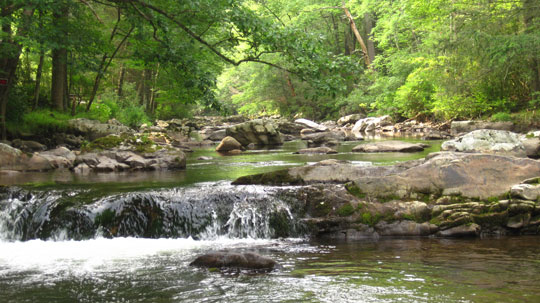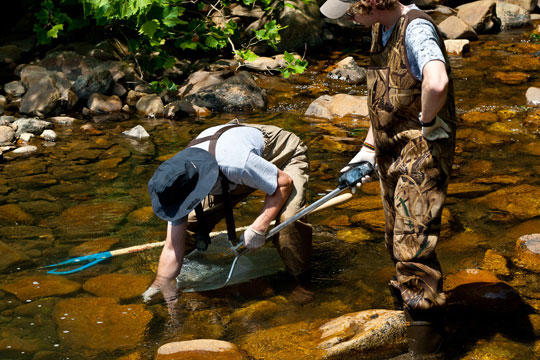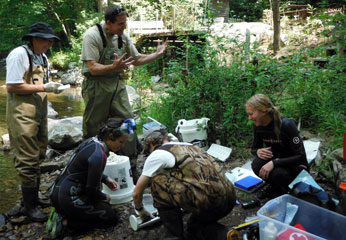Hellbent on hellbendering
What does it take to catch amphibians covered in mucus? Patience, a good sense of humor and a team of dedicated volunteers! Wildlife biologist Kim Terrell led an expedition through the rolling hills of Appalachia in search of the elusive hellbender. She details the highs and lows—from the satisfying “squish” of a successful catch to comical mishaps—in her latest notes from the field.
A team of scientists and keepers is traveling all over the eastern United States this year to study a unique and amazing animal: the hellbender.
The hellbender (Cryptobranchus alleganiesis) is the largest salamander in North America, third largest in the world behind the Chinese and Japanese giant salamanders. These fully aquatic salamanders are native to cold, fast-flowing Appalachian streams. It uses its rudimentary lungs primarily for buoyancy, and it has no gills—it “breathes” through its very wrinkled skin.
Terrell is studying how climate change affects hellbenders. Because warm water holds less oxygen than cold water, hellbenders may be even more at risk from climate change then terrestrial salamanders. This research will help ensure the survival of this unique Appalachian species.
Sunday, June 17, 2012
The National Zoo’s 2012 Hellbender Field Season has officially begun! Though I guess I should really call it a ”stream season,” since hellbenders don’t live in fields.
I left early this morning to drive down to my hellbender field site in southern Virginia (locations are not disclosed to protect the populations from poaching). On the way I stopped at the Zoo to analyze some white blood cells that I had collected last Wednesday from our hellbenders in Reptile Discovery Center. The cells are part of a study to investigate the effects of climate change on disease resistance in hellbenders. Because the cells are alive, I have to analyze them following a strict schedule. In this case it coincided with the day I was leaving on a week-long trip to survey hellbenders in the wild. Balancing our Zoo-based studies with a busy field season is going to be a challenge!
I met up with my field crew at an old ranch house nestled in the rolling hills of Appalachia. The U.S. Forest Service owns the house and allows visiting researchers to crash there for free, which is a huge help when you’re on a tight research budget. We’ve got a great mix of people in the field crew this year, and I’d like to introduce them:
- Lauren Augustine, an animal keeper at the Reptile Discovery Center;
- Brad Nissen, an intern in our Amphibian Research and Husbandry Program and recent grad of Mary Washington University;
- Dan Nissen, a retired hydrologist from the Virgnia Department of Environmental Quality (and Brad’s dad!);
- Jeff Storey, a graduate of Lord Fairfax Community College, wildlife photographer, and strongman (seriously—he plays in the Highland Games!);
- JD Kleopfer, a biologist for the state of Virginia Department of Game and Inland Fisheries and overall herpetological guru.
With the exception of JD and Lauren, none of the crew has ever seen a hellbender in the wild, so I really hope we catch something tomorrow. We caught several animals at this site last year, but hellbender populations are declining in many parts of their range, and it could be just a matter of time before they start declining in Virginia.
Monday, June 18
What a day! The first animal we caught was a juvenile, probably just three years old. This was really exciting because it’s getting pretty hard to find juvenile hellbenders in the wild (at least in most parts of their range). Scientists think that the lack of juveniles could mean that populations aren’t reproducing successfully, which would be bad news for the future of wild hellbenders. Finding a juvenile in our stream suggests that this particular population is doing well. Once we analyze the blood samples and skin swabs we’re taking from each hellbender, we’ll have a better idea of how healthy the population is.
After lunch we got back in the water and, after just three minutes of searching, I saw a GIANT head poking out from under a rock. I couldn’t believe it! Hellbenders usually stay completely concealed under rocks during the day, so I was surprised to find this one. I frantically called the rest of the crew over, and we positioned nets on each side of the rock. I was nervous to scare the hellbender away, because it was right next to a huge boulder that we’d never be able to lift. Fortunately, the rock the hellbender was under was tiny, not even big enough to cover its entire body. I picked up the rock with one hand and shooed the hellbender right into the net—it was textbook! This guy weighed about 600 grams, more than three times the size of the last one we caught!
After we released the big guy, we searched for another hour and came upon a third hellbender. This one was under a boulder, and we spent the next half hour trying to coax it out. Finally the hellbender saw a couple fish swim by and wiggled forward to investigate. I quickly grabbed it from behind and got it right into the net! This hellbender was a little smaller than the last one and a whole lot calmer. We got it to the bank, and I noticed it had a stumpy back leg. All the toes were intact, and it looked like the foot was in the process of regenerating! (Salamanders are the only animals with a backbone that can do this!) This was another good sign for the population. Hellbenders in Arkansas and Missouri have apparently lost the ability to regenerate their limbs, and biologists often find animals with missing toes and feet. It’s a great sign that we’re not seeing these abnormalities in the Virginia hellbenders.
After a long day, we headed back to the ranch. We’re going to try a night survey for the first time tonight. Because hellbenders are nocturnal, I’m hoping they’ll be out in the open, just waiting for us to scoop them up. It’d be great to be able to find them without having to turn over a single rock. The crew is really excited to try this out.
Tuesday, June 19
Well, last night’s hellbender survey was a total bust. We searched for an hour and a half and didn’t see a thing, except for some really big trout that were totally freaked out by my insanely bright submersible flashlight. I could hear their little fishy brains saying “Oh no, the sun is falling! Scared-scared-scared! Swim-swim-swim!” It was pretty cool snorkeling at midnight (though it didn’t seem as cool this morning when I rolled out of bed at 6:30 a.m. and put on a damp wetsuit).
JD joined up with us this morning and kicked the hellbender crew into high gear. Before the day was over, we had caught six hellbenders and sighted another two! (“Sighted” is the scientific way of saying we accidentally let them get away.) It was nuts! Every time Brad came back from processing a blood sample we had another hellbender that we were working up. We even found an itsy-bitsy guy that looked like he wasn’t even two years old. I was in heaven.
Wednesday, June 20
I don’t even know where to begin. Today the crew was bumped, bruised, drenched, pooped on, stung, pinched, panicked, parched, sweaty, and driven to extreme mental frustration. We visited a new hellbender site that was near a timber rattlesnake den that JD was monitoring. Lauren was ecstatic at the thought of seeing a rattlesnake in the wild, so first thing in the morning we scaled the side of a rocky mountain. There were no paths, so we plodded through a forest of poison ivy with the morning sun growing ever hotter. Just as we were about to give up the search, JD spotted a timber rattlesnake basking under a rock. It hung out for a while and gave us ample opportunity to ogle. It was totally worth the trip.
By the time we made it back down the mountain, we were wiped out. But after a quick break for water and granola bars, we were re-energized and ready to jump into the stream. Good thing, too—within ten minutes of searching we had caught two hellbenders. As Joey from the TV show Blossom would say, “Whoa!” Things were going great until we started searching for a third bender.
Just as we were about to lift a rock, Brad ran up to tell me that the centrifuge wasn’t working. “Is it plugged in?” I asked. Turned out it was plugged in and getting power, but some part of its mysterious inner workings was totally kaput. This was a disaster. Without the centrifuge I couldn’t spin the blood, which meant I wouldn’t be able to get a usable sample and there was no point in continuing the survey. We might as well pack up and head home, and just when things had really started rolling. It was hot, we were tired, we had blood samples that needed to be spun ASAP and everything hinged on fixing this piece-of-junk centrifuge.
While I was busy unplugging and re-plugging the centrifuge, Jeff decided to actually do something constructive and called the manufacturer. He determined that the problem was related to a bad connection and could (theoretically) be fixed with a bit of soldering. So began our quest for a soldering iron.
We found a guy on a tractor, who sent us to a guy at a nearby fish hatchery, who didn’t have an iron but thought he could help us fix it with some tools he had on hand. Standing there helpless, I felt like I was watching a life-or-death surgery. The centrifuge was belly up on the counter, with all its wires hanging out like intestines. After a half hour on the operating table, we put the centrifuge back together. I held my breath as Jeff plugged it in and turned up the speed dial . . . It worked! Relieved, I scrambled to get the blood samples loaded. But after just a few minutes of spinning, the centrifuge sputtered to a stop! Oh noooo, a relapse! It had spun just long enough for today’s samples, but we’d need a second surgery if we were going to collect anything tomorrow.
We said goodbye to our new friends at the hatchery and headed to the closest town, where we succeeded in finding a soldering iron. As we were making our way back to the van, we met up with two guys on motorcycles who had seen our gear and were curious to know what we were up to. Joe and Wayne, as they introduced themselves, had grown up in southern Virginia and had plenty of hellbender stories to share. Wayne had never heard the term “hellbender”, but had seen plenty of these “hogfish” when he was young. He didn’t hesitate to tell me that after catching a hellbender on a fishing line, he and his friends would drag it up to the bank, sharpen a stick, and stab it through the brain. (I know, it sounds awful. But they probably didn’t know any better, and that’s why we need to extend the zoo’s education efforts to rural communities.) Joe, on the other hand, said he knew that hellbenders (which he called “grampuses”) weren’t no trouble, and killing them was “something that us nice guys don’t do”. Joe had also spent every single day since his retirement fishing, and seemed to have a greater knowledge of the natural world than did his spear-throwing counterpart. He was really interested in learning more about the surveys, so we exchanged phone numbers and I promised to call him when I was back in town next summer. With that, we resumed our centrifuge mission.
We finally got back to the house just as it was getting dark, and Jeff spent the next several hours working on the centrifuge. After several more bouts of starting and stopping, he finally got it to work by bypassing every switch in the machine (meaning that it was constantly running when plugged in). Relieved and exhausted, we dragged ourselves to bed. I was so thankful to have someone on the crew with some wiring skills!
Thursday, June 21 (Our last day of hellbender surveys!)
We woke up this morning refreshed and ready for a new day of hellbendering. I was hoping to catch at least three more animals in order to get enough samples for my study. Lauren and Brad had left on Wednesday to return to work, so the group was down to JD, Jeff, Dan and me. We missed Lauren’s animal handling expertise and Brad’s technical skills, but we managed to remain a pretty efficient crew. We caught our quota of three hellbenders before lunchtime and decided to try a new site.
On Monday I had struck up a conversation with a guy hanging out of a pickup truck in a Food City parking lot. He had seen the realistic hellbender model that I keep on the van dashboard (exactly for the purpose of striking up random conversations) and wanted to know where I got it. He mentioned that he had some buddies who had caught some ‘benders at a fishing hole up the road, and this was a creek that I had been wanting to survey ever since I scoped it out last summer.
We eagerly headed out to the new site, but when we got there I started to have some doubts. Many of the big rocks were too embedded to have anything under them, and I started to feel like turning over each rock was just a formality before we could call it quits. There was no official record of hellbenders in this creek, and we were a good ways downstream from the fishing hole (which turned out to be just across the border into Tennessee, where I didn’t have a survey permit). But just when I was deciding this was a complete waste of time, I reached under a rock and felt the soft, familiar squish of a hellbender. YES!
This catch was a big deal—it represents a new record of a hellbender population in a state where the species has a very limited distribution. This kind of information is especially important right now because the U.S. Fish and Wildlife Service is considering this subspecies of hellbender (the eastern) as a candidate for endangered species listing. Knowing where a species occurs is the first step towards assessing its extinction risk. After another hour of searching we caught a second adult (a big fat one!) and a little juvenile. I couldn’t have imagined a better outcome—we found what appeared to be a high-density population with evidence of successful reproduction at a whole new site. What a fabulous way to end the trip!
Learn more about amphibian conservation
This post by WIldlife Biologist Kimberly Terrell was originally published by the National Zoo at http://nationalzoo.si.edu/
Posted: 3 July 2012
-
Categories:
Collaboration , Feature Stories , Science and Nature , Zoo & Conservation Biology Institute














